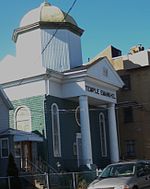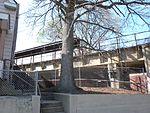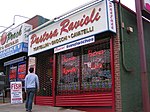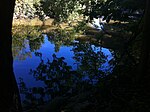Scott-Edwards House
Greek Revival architecture in New York CityGreek Revival houses in New York (state)Houses completed in 1730Houses on the National Register of Historic Places in Staten IslandNew York City Designated Landmarks in Staten Island ... and 6 more
New York City Registered Historic Place stubsStaten Island building and structure stubsStaten Island geography stubsUse American English from June 2022Use mdy dates from June 2022West New Brighton, Staten Island

Scott-Edwards House is a historic home located at West New Brighton, Staten Island, New York. It was built about 1730 and extensively remodeled in the 1840s in the Greek Revival style. The original section is a 1+1⁄2-story, stone structure with a clapboard upper section, originally in the Dutch Colonial style. The remodeling added a sweeping roof with an overhang supported by seven box columns. At the rear are two interconnecting frame additions completed about 1900.It was added to the National Register of Historic Places in 1983.
Excerpt from the Wikipedia article Scott-Edwards House (License: CC BY-SA 3.0, Authors, Images).Scott-Edwards House
Delafield Avenue, New York Staten Island
Geographical coordinates (GPS) Address Nearby Places Show on map
Geographical coordinates (GPS)
| Latitude | Longitude |
|---|---|
| N 40.628611111111 ° | E -74.123888888889 ° |
Address
Delafield Avenue
10310 New York, Staten Island
New York, United States
Open on Google Maps









